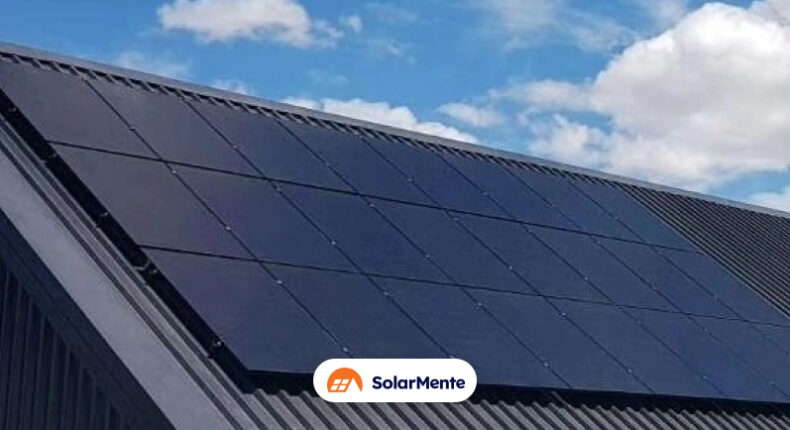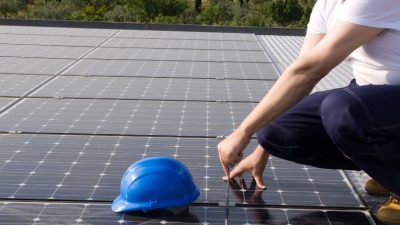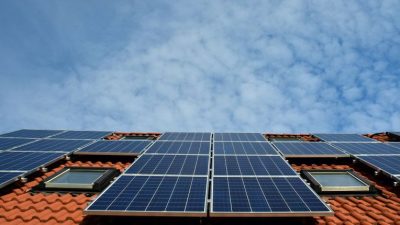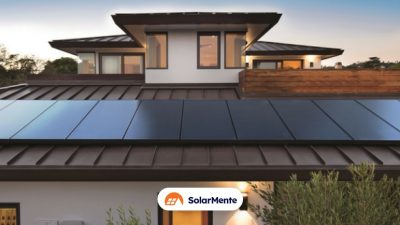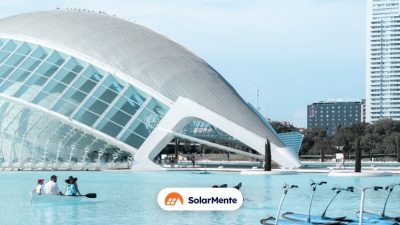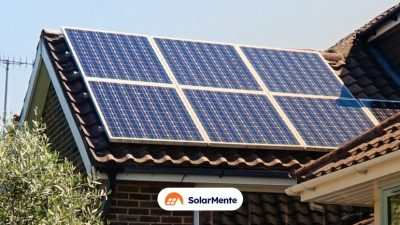When it comes to choosing a solar panel, what are the differences between one and the other? Do those intended for a solar garden have the same qualities as those intended for a home?
Despite the fact that module technology has improved considerably in the last decade, it is important to know the models on the market and to know which one is the most suitable for your home.
Because no. The quality used for the industrial sector is not the same as the one used for your home.
Nowadays, monocrystalline solar panels are the best option for producing solar energy in your home in the most efficient way and extracting the full potential of the system. In this way, you can reduce your electricity bill without harming the environment.
In this post we are going to explain what monocrystalline solar panels are, their characteristics, how efficient they are and what the differences are with respect to polycrystalline panels, among other interesting topics.
Let’s get to it!
What are monocrystalline solar panels?
When you hear about monocrystalline, polycrystalline or thin-film modules, you should bear in mind that these terms come from the manufacturing method used in solar panels.
Let us explain.
The main element of a solar panel is silicon and it is made up of several photovoltaic cells that are connected together, either in series or in parallel.
Because they are made of a single crystal, as the name suggests, the electrons have more space to move and the flow of electricity improves, and thus the efficiency of the photovoltaic system.
In short, their manufacturing method gives silicon a high purity that makes them the most efficient technology in small spaces or installations.
Characteristics of monocrystalline photovoltaic panels
First point to mention: how do we differentiate them from other modules?
Don’t worry. They are recognisable at first glance thanks to their dark (black) and uniform tone over the entire surface, whereas polycrystalline modules are perceived with a more bluish colour and the variety of crystals they contain can be easily visualised.
As for the size of the modules in the residential sector, they are usually made up of 60 cells, although in certain cases, they can be extended to 72. However, such cases are not the most common in this technology.
Monocrystalline modules measure around 164 cm x 99 cm.
And if you have already done some research on this type, you will know that the prices are higher compared to polycrystalline for a simple reason: the quality of these components allows them to produce energy at full capacity.
In short, their most important characteristics are as follows:
-
It is a slower manufacturing method, but it provides a purer silicon that improves the efficiency of the panels and therefore generates more energy.
-
They are very useful for geographic areas that do not enjoy full solar exposure during the day because they perform well in low light conditions.
-
They require more silicon and this translates into a higher price.
-
They are distinguished by their uniform dark colour.
-
They have a long lifetime, which with good maintenance of the solar panels, can reach up to 30 years.
Efficiency of monocrystalline panels
Monocrystalline solar panels have a higher efficiency than polycrystalline panels with percentages ranging from 17% to 20%.
This means that they require less space to achieve a given power capacity and monocrystalline panels have a higher power rating than polycrystalline and thin-film panels.
In short, monocrystalline technology needs fewer panels to produce the same amount of power and polycrystalline panels need more space to reach that figure.
In the end, they become the perfect alternative for small spaces.
However, new technologies are emerging that improve efficiency:
-
PERC solar panels. There is a layer placed between the silicon and the aluminium on the back side that prevents the solar radiation from penetrating the final layer of aluminium to absorb more energy and avoid temperature increase. With this technology, energy efficiency is between 19 % and 21 %.
-
N-type solar modules: the diffusion length is longer and therefore more impurities are avoided, achieving an efficiency of up to 22 %.
What is the difference between polycrystalline and monocrystalline solar panels?
The clearest difference between the two types of panels lies in the purity of the silicon due to the manufacturing process involved in each.
On the one hand, polycrystalline panels are manufactured by melting the silicon and then pouring it into moulds to obtain photovoltaic modules. Melting this material involves obtaining impurities with the consequent loss of efficiency. In the end, they are made of a wide variety of molten silicon crystals.
Monocrystalline solar panels, on the other hand, are not made from molten silicon, but are cut into sheets that avoid a significant decrease in efficiency through a higher purity of silicon.
However, in the following table you can see the differences between one type of panel and the other very precisely:
|
Indicators |
Polycrystalline |
Monocrystalline |
|
Design |
Blue |
Black |
|
Lifetime |
25- 30 years |
25- 30 years |
|
Space |
Needs more space |
No large locations required |
|
Efficiency |
Low |
High |
|
Price |
Low |
High |
Monocrystalline solar panels: our prices
As in any industry you are in, costs vary from one manufacturer to another. Not all offer the same quality or performance.
Even so, here are the approximate prices of the monocrystalline solar panels we work with at SolarMente:
|
Solar panels |
Price |
|
Kit M |
6.786€ |
|
Kit L |
8.114€ |
|
Kit XL |
9.538€ |
Please note that the price of the system includes the following items in addition to the modules themselves:
-
The solar inverter
-
The assembly
-
The labour
Why monocrystalline panels are the most suitable technology for your home
First of all, assessing the most suitable option for your home is an essential step that you cannot overlook. It is important to consider the different options on the market, i.e. what their characteristics are and whether they meet your needs.
At SolarMente, we only work with monocrystalline panels that ensure superior quality and efficiency in small spaces such as the roofs of residential installations. In addition, although it is not the most relevant factor, they have a more aesthetic design that integrates with the building without affecting the design.
Focusing on the residential sector, the most common and recommended are the 60-cell panels.
Sometimes our first impression plays tricks on us when we ask ourselves the following question:
Wouldn’t it be better to add more panels to increase our production?
Nothing could be further from the truth.
With an example, everything is simpler.
We can imagine that a 72-cell panel with 400W is a better option than a 60-cell panel with 340W.
But there is a problem in all this and that is that the 72-cell panel has two disadvantages: it takes up more space and its weight is higher.
Therefore, in a residential location we can place more panels composed of 60 cells that generate more solar energy.
Monocrystalline solar panel manufacturers that we work with at SolarMente
At SolarMente, we work with several manufacturers that allow us to offer you a variety of models to suit your preferences. Because what works for your neighbour is not necessarily the best option for you.
Here are the brands we work with today:
-
Hyundai
-
JA Solar
-
LONGiSolar
What other types of solar panels are there?
It is true that polycrystalline and monocrystalline panels are the best known in the sector, but we can find another type known as amorphous solar panels, which are less used due to their low performance .
The name itself comes from the use of thin layers of materials that offer more flexibility, but their efficiency is reduced to 8-14% and their useful life is not as long as that of the other types of panels mentioned.
The question is, where can we take advantage of this type of panel?
Although their performance is not suitable to cover the needs of a house, they are a good alternative for situations where a high energy production is not required, such is the case of garages, caravans or boats.
On the other hand, we should mention solar thermal panels, which are common in the residential sector.
Still, it is important to highlight the continuous development in the field of solar energy such as:
-
The use of panels for cars
-
Panels integrated in the building of the house itself
-
Roads as a source of electricity production
Thanks to new technologies, renewable energies are growing steadily. By this, we mean the emergence of artificial intelligence, Big Data or blockchain in solar energy, which are already revolutionising the energy market. The rules of the game will never be the same.
If, alongside these developments, we consider the new materials that are emerging such as photovoltaic glass and the evolution of production processes, the situation changes for the better.
Maximise your home’s solar system output with monocrystalline panels
The installation of one type of panel or another for your home influences the performance of the system, i.e. how much energy those solar panels are capable of producing and how long they will last.
And although monocrystalline solar panels have a higher price, in the long run, you will have more efficiency and performance even if the sun is not at full boiling point.
Therefore, this higher investment effort allows you to save more money on your electricity bill, forgetting about the volatility of market prices and enjoying 100% clean energy.
In addition, it has a more discreet design and some manufacturers ensure a guarantee of up to 25 years.
If you don’t want to wait any longer and get straight to the point, try our solar self-consumption calculator and stop imagining how much you can save on electricity.
Enter your consumption and find out in just a few seconds.

